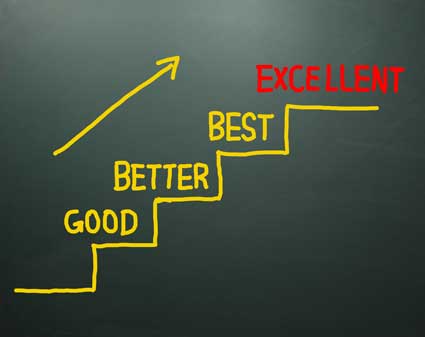So you completed your grant proposal and you're ready to send it out. Now what? Some people believe ardently that a grant proposal's success should depend on its content, not how it looks. Whether or not we agree, however, packaging and presentation are nearly always crucial. You need to be realistic in this regard because most people not only care what something looks like but they are affected by it, even if they do not fully realize that at the time.
Many grant writers say the cover letter is the most important part of a grant proposal.
Why? Because it is what people see first. If you can capture their attention, or even better, their imagination with your cover letter, you immediately will have separated your proposal from the pack and elevated it above the others.
Cover letters are particularly appropriate for local foundations, as they are a wonderful opportunity to make that personal link between your organization and the board and/or staff of the prospective grantor. The cover letter should be signed by the person in the grantee organization who has the closest link to the funder. If there is no one with a personal link to the foundation or corporation, the letter should be signed by the chief executive officer (CEO) or executive director.
While federal and state grants do not require cover letters, some grant writers still include one, considering it a courteous touch. You can check the request for proposals (RFP) guidelines or checklist requirements to determine whether you need or want to include one.
Cover letters certainly are relevant and pertinent for foundation and corporation requests.
As to the style of a cover letter, it should be insightful and from the heart, providing a tantalizing taste of what will come during the actual funding request. What a cover letter definitely should not be is a repetition of the executive summary; be careful on this point.
It is important to have the picture in your mind of what you want the prospective funder's reaction to be when he or she opens the request for assistance. You want that person to think that you have an understanding of the person or organization you have addressed the letter to, as well as a connection of some kind to your project.
Here is a quick checklist of points that are relevant to a cover letter, framed as questions that you should ask yourself to be sure that you leave out nothing relevant:
4 What do we know about the person who actually will receive the proposal and therefore the letter? Is there any particular point about him or her personally that could relate to the proposal?
4 Does the person who is going to sign my cover letter know the individual to whom the request is addressed? If so, do we use a first name or not?
4 How best can the letter not only address any funders' interests but relate them to our project?
4 What are the key points of the argument for funding? And how best are these laid out for the person receiving the letter?
4 If the cover letter is sent to a previous funder, was that entity suitably thanked for the last gift of funds? If the letter goes to a new funder, is there enough background and explanatory material to place everything into proper context?
4 Have I included any jargon? If so, remove it.
4 Have I given full and proper contact information?
4 Very importantly, is my cover letter two pages or less, preferably less?
Even if you include background information in the grant proposal, or as an attachment, you also should place some background information on your charity or organization in the cover letter.
The use of graphics in a grant proposal is good, just as long as those graphics can easily be included in the document and are counted as part and parcel of the page limit.
Charts and graphs are useful in illustrating a process, usually accomplishing this more easily than words. They also work well to define the management structure of an organization.
In general, though, please avoid using color; stick to either shading or line art instead. It was mentioned earlier that the use of color is often excluded from grant proposals. It is better to consider color prohibited, unless you are told otherwise.
Another reason for not using colored graphics relates to copying. Even though you may have attached the requested number of copies and more, the funder often will make additional ones. Nine times out of 10, those copies will not be colored ones.
This is where you can get away with things a little and sneak in a few extra points on a few extra pages. This is because attachment and appendix pages rarely are included in the page limit count, although sometimes a grantor will limit the number of pages allowed. Do not be greedy and overdo it, though.
Some examples of attachments that you should consider include:
¿ Internal Revenue Service (IRS) determination letter; i.e., proof of 501(c)(3) status required by foundations;
¿ the roster of board members;
¿ letters of support;
¿ news articles about the program;
¿ annual reports;
¿ recent audit statement.
People, not institutions, are what grants are all about. Your cover letter gives you the opportunity to show that you not only understand who your audience is but who will really be the recipient of the grant: not an organization but people.
Therefore, your cover letter really needs to reflect the style and character of the person who will sign the letter and, if possible, connect with the reader on personal and professional levels. The letter and proposal should be addressed to whoever has been nominated by the funder as the contact person, unless you have been informed otherwise. You may also copy the letter to someone else, such as a contact at the foundation or corporation.
Whomever you send the letter to and whomever you copy on it, just be sure that by doing so, you cover all your bases and respect the chain of command at the funding organization, while at the same time giving your proposal a more personal touch through personal contact.
You could very well think that a good cover letter summarizes your program and therefore could be substituted for an executive summary, but this is not true. There is or should be a distinctive difference between the cover letter and the executive summary.
The executive summary should be business-like and very straightforward, yet also convey your deep commitment to and passion for the project that is the subject of the grant proposal and its importance to all concerned.
You should include in the executive summary all the reasons for the funding, lifting the most significant sentences from each key area that you have written about in the proposal. It should be restricted to between half a page and one page in length.
Grants.gov, GrantStation.com, Scams, and Security
There are plenty of helping hands for you out there; many offline and online sources that you will find are a fantastic help not only with finding grants but in the actual writing process, and most of them are free.
Who or What Is Grants.gov?
Grants.gov is a government resource established as part of the President's 2002 Fiscal Year Management Agenda; it was one of 24 named in the E-Grants Initiative.
GrantStation.com operates as an online database company and is a great online resource for grant-seekers. It is not a free service but is very reasonably priced. Special discounted memberships often are available.
Although fewer foundations are included in its database (7,500-plus), that is because the company excludes those foundations that do not accept unsolicited proposals, fund only one or two organizations, or fund only scholarships.
Another way of putting it is that they have left out those that would not have been much good to you, anyway.
GrantStation.com takes a straightforward, streamlined approach in that it provides detailed information on what a foundation will support but leaves such extra details as trustee names and long lists of grants up to you to research when you visit the particular foundation's Web site. Links to all Web sites also are provided.
It is a very practical approach that saves you from becoming bogged down in looking through information that is generally only of possible interest later on in the grant process.
GrantStation.com has an excellent "field of interest" database search provision, offering lots of valuable choices. For example, under "Arts, Culture and Humanities," to list just a few, you will find:
1. Architecture
2. Art Education
3. Art History
4. Audience Development
5. Crafts
6. Dance
7. Ethnic/Cultural Awareness
8. Humanities
9. Literary Arts
10. Museums
11. Music
12. Opera
13. Photography
14. Theater
15. Visual Arts
In addition, each of these has a series of subsections.
You could then go onto "Civic Affairs," "Community and Economic Development," "Education," "Environment and Animals," etc.
We could go on and on, but by now you understand the wealth of information, advice, and help that is available at this site and the many others that make a grant writer's job much easier than it ever has been.
While grants help many people, you need to be very careful when commencing the task of finding a grant. Use common sense, be proactive, and realize that much grant information out there is free.
So if you choose to pay for help with finding a grant and/or writing the proposal, make sure that you are paying for a service, such as writing the grant proposal, for instance, rather than handing out money for information that you could have obtained for free yourself using terrific Web sites such as www.grants.gov or www.govbenefits.gov.
A few pointers for you to keep in mind that will help ensure that you are not scammed when looking into the possibility of obtaining a grant:
R You will not be contacted by the government wanting to offer you a grant.
R There are no fees associated with applying for a government grant; i.e., grant applications and information are free.
R All government grants are awarded for explicit and specific opportunities.
Unfortunately, however, it is not only the outside scammers you need to concern yourself with; you also need to keep an eye out for internal security problems that could lead to such things as waste, abuse, and even fraud.
There are some simple steps you can take to detect and prevent fraud, so do not become overly concerned with worry. There is no need if you follow these steps:
4 Establish an effective system of internal control, including accounting and records control, as well as records retention.
4 Develop and implement an internal compliance and ethics program that genuinely encourages the recognition and reporting of abuse, waste, and fraud.
Personal security is something we should always be aware of, but usually basic common sense is enough to safeguard our interests in relation to anything to do with grants.
For instance, let me ask you a question: Should you be willing to provide personal information, such as Social Security number, banking, or credit card information, to a grant provider? No, of course not.
By far, the majority of grant proposals you will submit will be in the usual way. However, you need to be flexible; i.e., you need to at least be aware of the other types and methods of submission.
A number of smaller foundations may ask you to put your grant proposal in a letter format, often specifying the number of pages you can submit.
One reason is that often these smaller foundations have little or no staff to assist the trustees. Therefore, a proposal in the form of a letter is a practical means of reducing the quantity of material they need to evaluate when they are trying to reach a grant-making decision.
Keeping this factor in mind, you should conscientiously adhere to any length restrictions and refrain from using attachments that have not been requested to get around those length restrictions. They most probably will not be read and could possibly leave a bad taste in the trustee's mouth.
Of course, this does not mean that you should not send any attachments at all because funders who ask for their grant proposals to be done in letter form usually will ask for a separate program budget and proof of nonprofit status as attachments.
You also might want to include a brochure about your organization. This would not add greatly to the bulk of the letter and would give the prospective funder some needed background information about your organization.
The trick with a letter proposal is to remember that it must function by itself to accomplish several things:
v Operate as a cover letter by making that personal connection with the grant reader while at the same time tying the proposal to the funder's interests;
v Act in the role of executive summary, laying out in abbreviated form the critical points of the grant proposal;
v Make sure all parts of a full proposal are covered, such as (i) the statement of needs, (ii) process, (iii) objectives, (iv) goals, (v) key personnel, and (vi) evaluation procedure;
v Supply a framework for and references to the budget.
The use of forms for grant proposals varies widely from funder to funder. Sometimes the forms operate just as cover sheets, but others operate in the role of a full proposal.
Form proposals give funders the information in a uniform format from every single applicant, making evaluation of the proposals easier. Form proposals also serve to reduce the distinctions between proposals, such as whether they come from big or small organizations. Therefore, forms seemingly make the process fairer and create a level playing field.
Another thing that is guaranteed when presentation and formatting are uniform is the quality of the writing, meaning that it is necessary to do a superior job when preparing your grant application form, restricting verbiage so the proposal does not exceed any limit.
A certain number of regional associations go so far as to provide a standardized application form that is accepted by many of its members. It is handy to note that the Forum of Regional Associations of Grantmakers (www.givingforum.org), Foundation Center (www.fdncenter.org), GrantStation (www.grantstation.com), and several other organizations offer access to many of the forms accepted in various regions.
Every single year, submission of grant applications online or by e-mail is becoming more and more common. In some cases, paper submission is either actively discouraged or eliminated altogether.
Online applications usually involve a form that prompts you to enter your information one piece at a time. While in some cases, you will be able to check out all the questions before you need to actually begin filling out the proposal, other funders are not quite so considerate.
The big disadvantage to grant writers with online presentation is that every single application will appear identically formatted and presented. This makes it just about impossible for a writer to give a proposal any personality or personal touches at all.
If at all possible, make sure you download and print out not only the application form but all instructions connected to it so that you can draft your proposal as many times as you like using the actual form itself.
It is amazing how many experienced writers do not save their work as they go. It is crucial as you proceed through the actual online application process that you do so. That way, you will not lose a lot of hard work if you experience any Internet glitches.
































